Question 1: An object experiences a net zero external unbalanced force. Is it possible for the object to be travelling with a non-zero velocity? If yes, state the conditions that must be placed on the magnitude and direction of the velocity. If no, provide a reason.
When an object experiences a net zero external unbalanced force, in accordance with the second law of motion, its acceleration is zero. If the object was initially in a state of motion, then in accordance with the first law of motion, the object will continue to move in the same direction with the same speed. It means that the object may be travelling with a non-zero velocity, but the magnitude as well as direction of velocity must remain unchanged or constant throughout.
Question 2: When a carpet is beaten with a stick, dust comes out of it. Explain.
The carpet with dust is in a state of rest. When it is beaten with a stick, the carpet is set in motion, but the dust particles remain at rest. Due to the inertia of rest, the dust particles retain their position of rest and fall down due to gravity.
Question 3: Why is it advised to tie any luggage kept on the roof of a bus with a rope?
In a moving vehicle like a bus, the motion is not uniform; the speed of the vehicle varies, and it may apply brakes suddenly or take a sudden turn. The luggage will resist any change in its state of rest or motion due to inertia, and this luggage has the tendency to fall sideways, forward, or backward. To avoid the fall of the luggage, it is tied with a rope.
Question 4: A batsman hits a cricket ball which then rolls on a level ground. After covering a short distance, the ball comes to rest. The ball slows to a stop because
- (a) the batsman did not hit the ball hard enough.
- (b) velocity is proportional to the force exerted on the ball.
- (c) there is a force on the ball opposing the motion.
- (d) there is no unbalanced force on the ball, so the ball would want to come to rest.
(c) there is a force on the ball opposing the motion.
Question 5: A truck starts from rest and rolls down a hill with a constant acceleration. It travels a distance of 400 m in 20 s. Find its acceleration. Find the force acting on it if its mass is 7 tonnes (Hint: 1 tonne = 1000 kg).
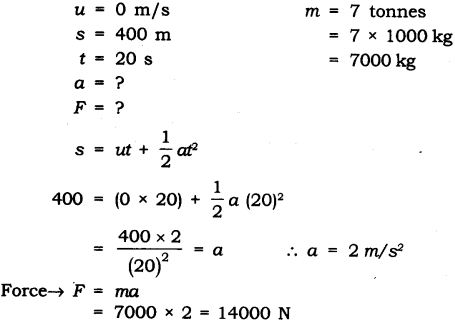
Question 6: A stone of 1kg is thrown with a velocity of 20 m/s across the frozen surface of a lake and comes to rest after travelling a distance of 50 m. What is the force of friction between the stone and the ice?
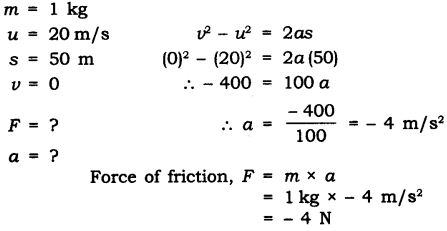
Question 7: A 40000 kg engine pulls a train of 5 wagons, each of 2000 kg, along a horizontal track. If the engine exerts a force of 40000 N and the track offers a friction force of 5000 N, then calculate:
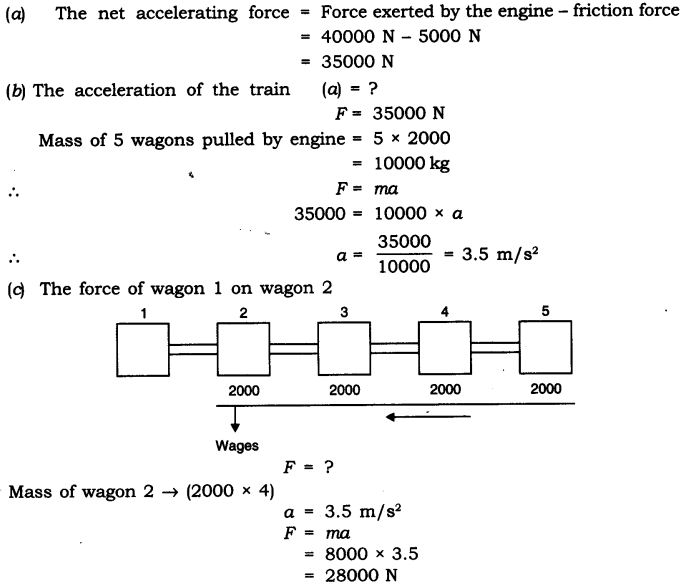
Question 8: An automobile vehicle has a mass of 1500 kg. What must be the force between the vehicle and road if the vehicle is to be stopped with a negative acceleration of 1.7 ms-2?
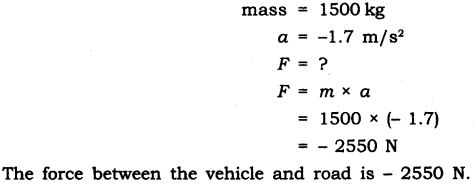
Question 9: What is the momentum of an object of mass m, moving with a velocity v?
- (a) (mv)2
- (b) mv2
- (c) 1/2 mv2
- (d) mv
(d) mv
Question 10: Using a horizontal force of 200 N, we intend to move a wooden cabinet across a floor at a constant velocity. What is the friction force that will be exerted on the cabinet?
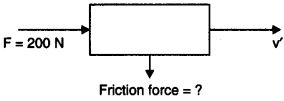
As the wooden cabinet moves across the floor at a constant velocity and the force applied is 200 N. Hence the frictional force that will be exerted on the cabinet will be less than 200 N.
Question 11: Two objects each of mass 1.5 kg, are moving in the same straight line but in opposite directions. The velocity of each object is 2.5 m/s-1 before the collision during which they stick together. What will be the velocity of the combined object after the collision?
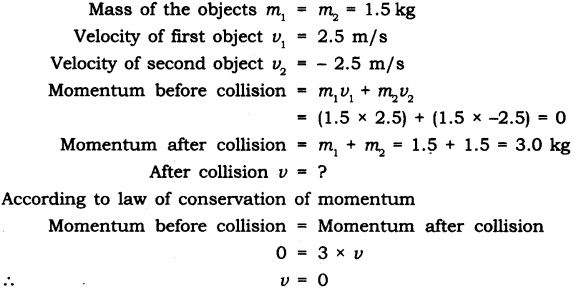
Question 12: According to the third law of motion when we push on an object, the object pushes back on us with an equal and opposite force. If the object is a massive truck parked along the roadside, it will probably not move. A student justifies this by answering that the two opposite and equal forces cancel each other. Comment on this logic and explain why the truck does not move.
The mass of the truck is too large, and hence its inertia is too high. The small force exerted on the truck cannot move it, and the truck remains at rest. For the truck to attain motion, an external large amount of unbalanced force needs to be exerted on it.
Question 13: A hockey ball of mass 200 g traveling at 10 m/s is struck by a hockey stick so as to return it along its original path with a velocity of 5 m/s. Calculate the change of momentum occurred in the motion of the hockey ball by the force applied by the hockey stick.
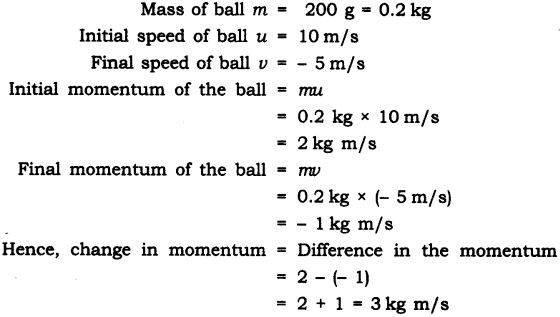
Question 14: A bullet of mass 10 g traveling horizontally with a velocity of 150 m/s strikes a stationary wooden block and comes to rest in 0.03 s. Calculate the distance of penetration of the bullet into the block. Also, calculate the magnitude of the force exerted by the wooden block on the bullet.
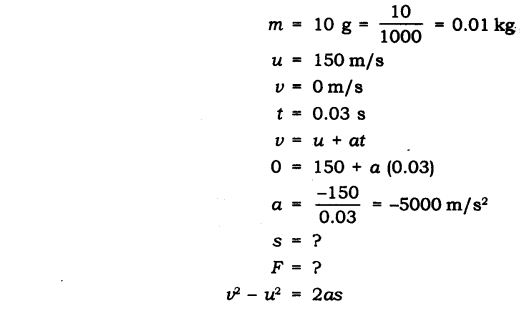
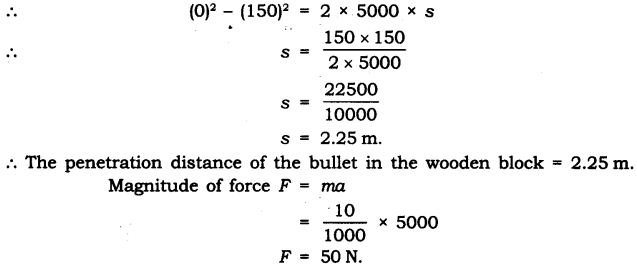
Question 15: An object of mass 1 kg traveling in a straight line with a velocity of 10 m/s collides with, and sticks to, a stationary wooden block of mass 5 kg. Then they both move off together in the same straight line. Calculate the total momentum just before the impact and just after the impact. Also, calculate the velocity of the combined object.
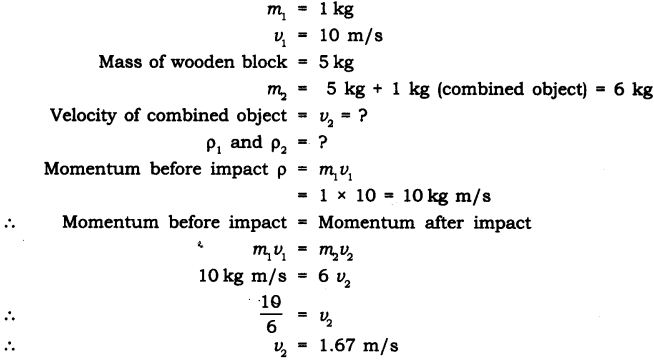
Question 16: An object of mass 100 kg is accelerated uniformly from a velocity of 5 m/s to 8 m/s in 6 s. Calculate the initial and final momentum of the object. Also, find the magnitude of the force exerted on the object.
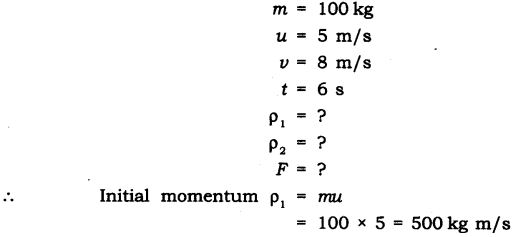
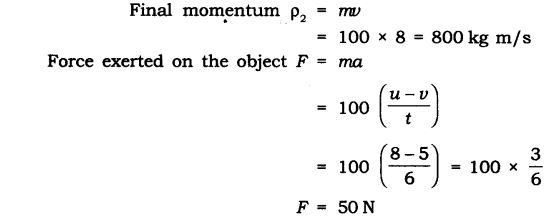
Question 17: Akhtar, Kiran, and Rahul were riding in a motorcar that was moving with a high velocity on an expressway when an insect hit the windshield and got stuck on the windscreen. Akhtar and Kiran started pondering over the situation. Kiran suggested that the insect suffered a greater change in momentum as compared to the change in momentum of the motorcar (because the change in the velocity of the insect was much more than that of the motorcar). Akhtar said that since the motorcar was moving with a larger velocity, it exerted a larger force on the insect. And as a result, the insect died. Rahul, while putting an entirely new explanation, said that both the motorcar and the insect experienced the same force and a change in their momentum. Comment on these suggestions.
Rahul gave the correct reasoning and explanation that both the motorcar and the insect experienced the same force and a change in their momentum. As per the law of conservation of momentum, when two bodies collide, the initial momentum before the collision is equal to the final momentum after the collision. The equal force is exerted on both the bodies, but because the mass of the insect is very small, it will suffer a greater change in velocity.